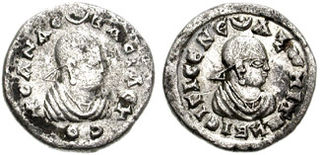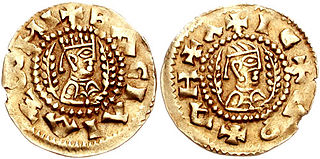Related Research Articles

Menelik I was the legendary first Emperor of Ethiopia. According to Kebra Nagast, a 14th-century national epic, in the 10th century BC he is said to have inaugurated the Solomonic dynasty of Ethiopia, so named because Menelik I was the son of the biblical King Solomon of ancient Israel and of Makeda, the Queen of Sheba.
Cush or Kush, according to the Hebrew Bible, was the oldest son of Ham and a grandson of Noah. He was the brother of Mizraim, Phut, and Canaan. Cush was the father of Nimrod.

The Zagwe dynasty was a medieval Agaw monarchy that ruled the northern parts of Ethiopia and Eritrea. The Agaw are a Cushitic ethnic group native to the northern highlands of Ethiopia and neighboring Eritrea. Centered at Roha, it ruled large parts of the territory from approximately 1137 to 1270 AD, when the last Zagwe King Za-Ilmaknun was killed in battle by the forces of the Amhara King Yekuno Amlak. The Zagwe are most famous for their king Gebre Meskel Lalibela, who is credited with having ordered the construction of the rock-hewn monolithic churches of Lalibela.

Kaleb, also known as Saint Elesbaan, was King of Aksum, which was situated in modern-day Ethiopia and Eritrea

Ousanas was a King of Axum. Stuart Munro-Hay believes that it is "very likely" that Ousanas is the king to whom Aedesius and Frumentius were brought. In Eritrean and Ethiopian tradition, this king is called Ella Allada or Ella Amida. Ella Amida would then be his throne name, although Ousanas is the name that appears on his coins. If this identification is correct, then it was during his reign that Christianity was introduced to Axum and the surrounding territories.

Israel was a king of Axum. He is primarily known through the coins minted during his reign. He is one of several Aksumite kings with a Biblical name, the others include Ioel, Kaleb, Gersem, and likely Noe; Richard Pankhurst mentions the name of this king as an early example of Judaic influence in Ethiopian culture.

Gersem was a King of the Kingdom of Aksum in Northeast Africa. He is primarily known through the Aksumite currency that was minted during his reign.
Mara Takla Haymanot was King and the founder of the Zagwe dynasty. Some king lists give his name simply as "Mararah", and other King Lists as "Takla Haymanot".

Kandake, kadake or kentake, often Latinised as Candace, was the Meroitic term for the sister of the king of Kush who, due to the matrilineal succession, would bear the next heir, making her a queen mother. She had her own court, probably acted as a landholder and held a prominent secular role as regent. Contemporary Greek and Roman sources treated it, incorrectly, as a name. The name Candace is derived from the way the word is used in the New Testament.
Ethiopian Greeks, or Greeks in Ethiopia, are ethnic Greeks from Ethiopia. Today they number about 500 persons and can be traced back to ancient times. They are mainly located in the capital, Addis Ababa, and the city of Dire Dawa.
African Greeks, or Greeks in Africa, are the ethnic Greek people living in the continent of Africa. Greek communities have existed in Africa since antiquity.
Ethiopian historiography includes the ancient, medieval, early modern, and modern disciplines of recording the history of Ethiopia, including both native and foreign sources. The roots of Ethiopian historical writing can be traced back to the ancient Kingdom of Aksum. These early texts were written in either the Ethiopian Ge'ez script or the Greek alphabet, and included a variety of mediums such as manuscripts and epigraphic inscriptions on monumental stelae and obelisks documenting contemporary events. The writing of history became an established genre in Ethiopian literature during the early Solomonic dynasty (1270–1974). In this period, written histories were usually in the form of royal biographies and dynastic chronicles, supplemented by hagiographic literature and universal histories in the form of annals. Christian mythology became a linchpin of medieval Ethiopian historiography due to works such as the Orthodox Kebra Nagast. This reinforced the genealogical traditions of Ethiopia's Solomonic dynasty rulers, which asserted that they were descendants of Solomon, the legendary King of Israel.
The 1922 regnal list of Ethiopia is an official regnal list used by the Ethiopian monarchy which names over 300 monarchs across six millennia. The list is partially inspired by older Ethiopian regnal lists and chronicles, but is notable for additional monarchs who ruled Nubia, which was known as Aethiopia in ancient times. Also included are various figures from Greek mythology and the Biblical canon who were known to be "Aethiopian", as well as figures who originated from Egyptian sources.
Regnal lists of Ethiopia are recorded lists of monarchs who are claimed by tradition to have ruled Ethiopia. These lists are often recorded on manuscripts or orally by monasteries and have been passed down over the centuries.

Angabo or Agabos was a legendary king of Ethiopia who killed the evil serpent king Arwe and was either the father or husband of the Queen of Sheba. He was sometimes called Za Besi Angabo.

Gebre Meskel also known as Gabra Masqal was a King of Axum who reigned in the 6th century. He was a son of Kaleb of Axum and brother to Israel of Axum. His reign is most notable for the compositions of hymns by the Ethiopian saint Yared.
Ayzur or Izoor was a king of Axum who reigned for half a day according to the traditional regnal lists.
References
- 1 2 3 Bekerie, Ayele (2004). "Ethiopica: Some Historical Reflections on the Origin of the Word Ethiopia". International Journal of Ethiopian Studies. 1 (2): 113. JSTOR 27828841.
- ↑ "Ethiopia". Berhan Ethiopia Cultural Center. Retrieved February 20, 2017.
- 1 2 Budge, E. A. Wallis (1928). A History of Ethiopia: Nubia and Abyssinia (Volume 1). London: Methuen & Co. pp. 192–193.
- ↑ Africa Geoscience Review. Rock View International. 2003-01-01. p. 366.
- ↑ Budge, E. A. Wallis (1928). A History of Ethiopia: Nubia and Abyssinia (Volume 1). London: Methuen & Co. p. 143.
- ↑ Budge, E. A. Wallis (1928). A History of Ethiopia: Nubia and Abyssinia (Volume 1). London: Methuen & Co. p. ix.
- 1 2 3 Rey, C. F. (1927). In the Country of the Blue Nile. London: Camelot Press. pp. 265–266.
- 1 2 Bekerie, Ayele (2004). "Ethiopica: Some Historical Reflections on the Origin of the Word Ethiopia". International Journal of Ethiopian Studies. 1 (2): 113. JSTOR 27828841.
- ↑ Snowdem, Frank M. (1970). Blacks in Antiquity: Ethiopians in the Greco-Roman Experience. Harvard University Press. p. 155. ISBN 978-0-674-07626-6.
- 1 2 For all references to Ethiopia in Herodotus, see: this list at the Perseus Project.
- ↑ Fage, John (23 October 2013). A History of Africa. Routledge. pp. 25–26. ISBN 978-1317797272.
- ↑ Herodotus. "The Histories Book II Chapters 99-182". penelope.uchicago.edu.
- ↑ Peter Lundström. "Comparing Manetho" . Retrieved 29 October 2022.
- ↑ Hatke, George (2013). Aksum and Nubia: Warfare, Commerce, and Political Fictions in Ancient Northeast Africa. NYU Press. pp. 52–53. ISBN 978-0-8147-6066-6.
- ↑ Budge, E. A. Wallis (1928). A History of Ethiopia: Nubia and Abyssinia (Volume 1). London: Methuen & Co. p. vii.
- ↑ Budge, E. A. Wallis (1928). A History of Ethiopia: Nubia and Abyssinia (Volume 1). London: Methuen & Co. p. vii-viii.
- ↑ Budge, E. A. Wallis (1928). A History of Ethiopia: Nubia and Abyssinia (Volume 1). London: Methuen & Co. p. viii.